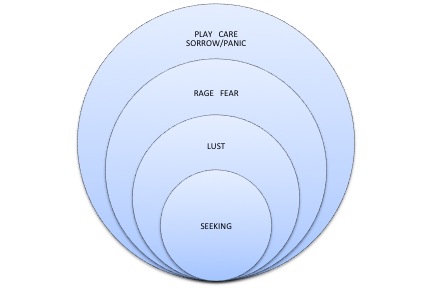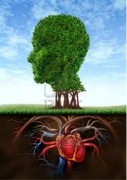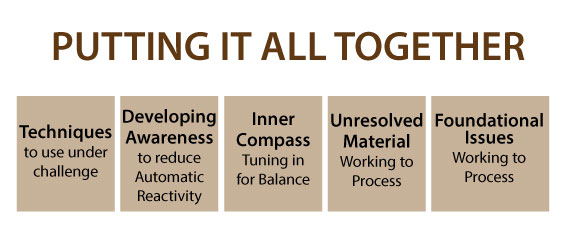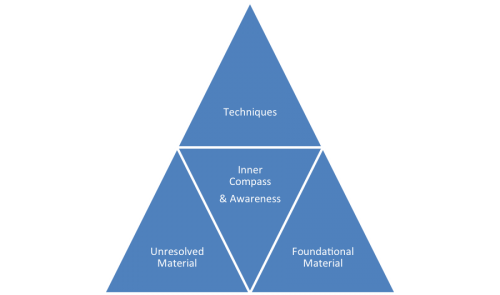Theoretical Orientation
A therapist has typically spent a lot of time studying approaches to the mind, to resolving mental and emotional issues, and to understanding people on a human level in the end. I would like to share with you some of the areas of study that have called me and what I bring to the therapy encounter
Below are six of the major areas I consider fascinating and important in the work of therapy. You can click on any of these subjects to look at a particular area, or simply explore as you scroll down. There is a lot of material here and I might suggest you browse it first and just see what is there, then focus in on the areas that interest you.
The areas are:
- Wisdom of the Body and of Intuition
- Spectrum Model of Mental Health Issues
- Attachment and the Window of Affect Tolerance
- Affective Neuroscience: Understanding the Core Emotions as they Evolved Over Time
- Biological Foundations Of Mental Health
- Putting it Together: An Overall Approach to What is Happening in Therapy
- Perspective
Wisdom of the Body and of Intuition
I like science, and there is a lot of it that applies to therapy.
But I also like the other side, the “right brained” part of being human.
Partly because science is still an incomplete and partial explanation for what happens in our lives, and partly because there is something special about the other side of knowledge that which comes to us through intuition, through felt sense, through trusting the self – I have always been partial to the many techniques and awareness’s that bring us in touch with ourselves through a felt sense or sense of knowing. These days, the acceptance of Mindfulness and Mindfulness Based Meditation goes far to validate that knowledge in a wider circle. I am glad that mindfulness and other openings to this side of the self are being used more widely, and I continue to use them in my practice and my daily life.
I find this very important and in a sense it is a bridge between the intuitive and the scientific.
The purely scientific and “left brained” side of things sees diagnostics as a system that delineates specific and unrelated diagnostic categories to be treated. Things like depression, ADD, Panic Disorder, etc sound like they are “things” that need to be treated in and of themselves. Add in the fact that many biological and health issues ultimately impact the brain and therefore your states of mind and emotion, there is another way to look at all of this and it is summarized in the diagram below.
This diagram is telling us there is another way to look at all this. It says the brain itself functions as a dynamic equilibrium between multiple factors. These factors shift the brain from the middle of this diagram where things are optimal and more or less balanced, to the left or right side, where the functioning of the brain is progressively compromised. As you can see in this image, as the function of the brain moves towards one side or the other, basic processes change, more or less of certain neurotransmitters are available, the brain speeds up or slows down. As this type of change occurs, the types of problems that we describe as a particular diagnosis arise based on these underlying factors being out of balance. Thus as a brain is speeding up for example, Anxiety is a greater and greater tendency, and if this continues, over thinking begins to feel natural. The far end of the spectrum is what we are calling positive Schizophrenia, which needs a variety of factors, with a big genetic component for the brain to move that far to the right. But you see what I am talking about here.
Thus, when you work with me, you may get a diagnosis, but I am much more focused on seeing the issues you are experiencing based on this chart and this kind of understanding. This is also where the brain maps I make are particularly enlightening, and where neurofeedback can actually shift the brains functioning itself, directly. More on those things available here.
So, you should know that when you work with me, I am thinking in this way. I find it to be very valuable in seeing things as they truly are, and not pigeonholing people, and also in finding a way to shift things in a positive direction.
Attachment and the Window of Affect Tolerance
Attachment Theory, which developed with the study of rhesus monkeys, like the one above is another important part of how I look at how people function emotionally. The fact that we need some form of attachment in our early years was given scientific credence by these early studies. The recognition that as infants we are initially unable to control our emotions, almost at all, came to be understood in terms of how we wind up “wiring differently” in our first few years. Our brains really do wire up in the first few years, being born with all the parts of the brain, but many connections needing to be made between them, what happens during those years leaves a lasting functional impact. The bonds with parents help us to deal with feeling scared, cold, hungry, lonely etc on a daily basis. And some combination of how your parents themselves are “wired” (all those years after their own infancy) plus your own inherent tendencies, gives rise to a style of managing emotion and keeping emotions within a manageable range when upsets come.
There have been 4 styles of emotional managing that have been described and studied. For now let’s just say that the way you are is very set, and while it can change little by little with effort, it’s not something to be taken lightly. And if for example you and your spouse are wired in opposite styles (which happens pretty often) there are going to be many times where you simply cannot understand how the other is acting, and it’s going to feel like you either cannot get what you need, or just can’t reason with them. This is of course particularly important in couples counseling.
For now I would like to show you another diagram – The Window of Affect Tolerance
What this diagram is telling us is that for all of us, however we are wired to control potentially upsetting and even destabilizing emotions, there is a basic range of arousal we need to stay in. When we get outside that range, we begin to lose mental clarity, do and say things we shouldn’t,lose almost all ability to communicate or make decisions effectively, and in the end, need some time for the emotions and stress hormone circulations in our bodies to settle down before we can get back within the “Window of Affect Tolerance” and become functional again.
This is a very useful diagram for people to have and keep in mind in terms of emotional difficulties we encounter. Once our system moves “outside the window” our biological mechanisms take over and we are unable to manage our emotions. Learning to recognize the warning signs and take preventative measures is the goal. Couples in distress do this to each other all the time and need to stop if they are going to be able to repair their relationships. This is something you will hear me talk about a lot and use a lot in therapy, and it is good for you to have an idea yourself of what this is.
Affective Neuroscience: An Understanding of the Core Emotions as they Evolved Over Time
Affective Neuroscience is a field I am particularly fond of – it explains and puts into perspective so much about the complexity of emotions that we all experience, whether we hold them tight to the chest as some forms of attachment do, or we engage actively in them and feel like we need that coming back to feel safe. Affective neuroscience is the field of the study of emotional networks in the brain.
Let’s have a look at a very basic diagram:
This understanding describes actual brain networks painstakingly searched out and delineated through all manner of scientific experimentation and observation, over at least 30 years by many many researchers and scientists. The basic overall framework is described in the writings of Jaak Panksepp.
They describe a series of emotions some much older and correspondingly deeper in the brain, and others newer, and further up into the newer regions. All of them of course make connectins to the newer cortex that we humans all use. This information shows us that we share the same basic networks pretty closely with most mammals and share some of the older ones with reptiles. Our emotions are very related to the emotions of animals, ours just have a more complex” finishing touch” supplied by our cortex and overall more complex brains.
Although there are seven basic emotions (or emotion networks), all of them weave through various regions of the brain interacting with other systems, networks, memories, and ideas. The ways in which all of these combine makes the kinds of emotions we can feel to be countless.
But understanding for example that there is an older survival fear network and a distinct social connection and nurturance network. Losing connection or being unable to care for a close one (Cue the codependent behaviors) can set off an intense form of anxiety. But it is neurologically and biochemically different than the survival fear network, that is older and more basic. Knowing the difference between these two fear networks is especially helpful, particularly since our language and our concepts do not generally distinguish between these very different systems Our basic drive to seek out what we need, based in the daily search for food, for shelter, for others of our kind is still with us. But because our more complex brains can identify things that are more abstract and identify them as a need, kicks in this old system and sometimes causes us to become excited about pursuing things that are really not that essential. Some people think this is one of the key elements in addiction, perhaps especially the non substance addictions that are so prevalent these days.
Another thing we learn is that Play seems to be a deeply embedded and important aspect of our emotional well being. Any litter of baby animals I’ve ever seen engages in joyful rough and tumble play. It develops all sorts of relational behaviors and self defense skills to be used later when things are serious. We have this network too, and again as more complex humans, we can and do develop endless forms of play. When they are not intense competition, they are also fun and can bring joy – although sometimes we become more attached to winning and succeeding, and this brings in other emotional systems. But play can beget joy and is a part of an overall balance of emotions.
This detailed description of emotions, what they are and how they relate to each other is a daily guide and a map for me. I find it to be invaluable in helping to reach understanding of emotional activations and their expressions. It seems to me to be a key to what is and I am glad to add it to the other maps I have and am describing to you.
Biological Foundations Of Mental Health
The brain for all its uniqueness is still an organ that is both affected by the general health of the body, and has its own health issues. Like other organs too, it is adept at maintaining its function as its health begins to slide, doing the most it can with slowly reducing states of health, until reduction of function begins to creep in. There is a growing understanding in the field that brain health goes way beyond sluggish thyroid problems that can create depression. The brain is impacted not only by these types of biological imbalances in other organs, but also by its own responses to stress that can accumulate over time. Issues like toxins, inflammatory processes, gluten sensitivity and many others can create minor and cumulative symptoms that take a long time to reach the state of a disease entity. It wouldn’t be diagnosed as a medical condition, but it could easily make subtle and growing changes to the way the brain networks function causing a slow creep of decreasing function. Because of this, I do what I can to help you discover the contribution any such processes may be having on your own brain function. “Sometimes a cigar is just a brain inflammatory process.”
I offer an online survey you can take that helps us to narrow down the possibilities of such issues for your brain. For more information you can click here.
Putting it Together: An Overall Approach to What is Happening in Therapy
Therapy is a dynamic process of change. Some of it proceeds from a person steadily working away at patterns and responses so that they begin to get initial changes. Then, as we stay with it, these changes begin to become engrained. Knowing where to focus in a complex system of a person’s psychology and being is a challenge. Luckily for us, we don’t have to know exactly to get it right. There are usually any number of places we can focus that will bring change and progress.
Here is one way I keep track of where we are and where we need to go as we apply all of the above.
Keeping it simple for now, I have divided up some of the tasks and focuses of therapy into 5 categories.
Techniques is the most superficial level, a momentary challenge of anxiety, of compulsion, of lack of focus. Under this kind of challenge the realm of tools and techniques are especially useful, that’s the first box.
Next we have the overall skill and aptitude of Developing Awareness. As we do this the moments of dysregulation and distress are much less likely to creep up on us and easier to adjust to when they do.
This means basically putting in work to build up more awareness to the signs and signals that are there,
so you are more informed, more able to follow and track what is going on inside of you.
Next, Inner Compass refers to developing a sense of balance within the self that can be tuned into. This may take the form of deep breathing, mindfulness, tuning into the body, physical activity while relaxing, etc. This becomes a resource to counterbalance the challenges that come along moment by moment.
It is sometimes referred to as the development of resilience.
Deeper than this, we know that sometimes in therapy we have to focus on unresolved experiences in life. These experiences continue to skew the way we feel about ourselves, unbalance the emotional ebbs and flows of our days, and distort our ability to see the world and our life with clarity. This includes issues of trauma as well as less damaging but still unresolved life experiences. It is in a sense the traditional realm of psychotherapy. This map allows us to move from one realm to another, bringing in the tools appropriate to the task.
And finally, Foundational issues. This is the realm of attachment and early experiences that lay down basic patterns of response to people and the world. Sometimes we need to process these as well to give a person a greater range of flexibility in their lives. We don’t simply change these things, we can’t, but we can get more fluidity and more ability to meet others halfway. This type of work tends to improve the ability to engage in healthy relationships and to increase emotional flexibility.
The way I represent this in a simple image is this pyramid I created. It is a handy reference for you to refer to, to locate where you are in the process or where you may want to go next. We can discuss this between us to clarify where we are in the therapy at any given time.
Perspective is the overall framework that all of these things fit into.
Imagine we were take the pyramid and put it inside a big circle. And that circle holds what this all means. Therapy has the potential, once you have done all this work, to integrate into your own personal sense of meaning
The inner circle here would be Narrative – the story you tell yourself about what is happening – It’s the way you manage and make sense of the events of your life.
The next layer out is Context – How you see the things that are happening to you and your people in the bigger picture of everything that is happening in your life and how it matters.
The Larger layer still is Meaning itself.
This can constitute many things for many people. It can be in the spiritual realm, the realm of what you are most committed to, the realm of purpose in life. These are quite personal realms and sometimes in therapy we need to touch base consciously with them – to move the overall process along, and to keep it from getting bogged down in old meanings that no longer work for you.










